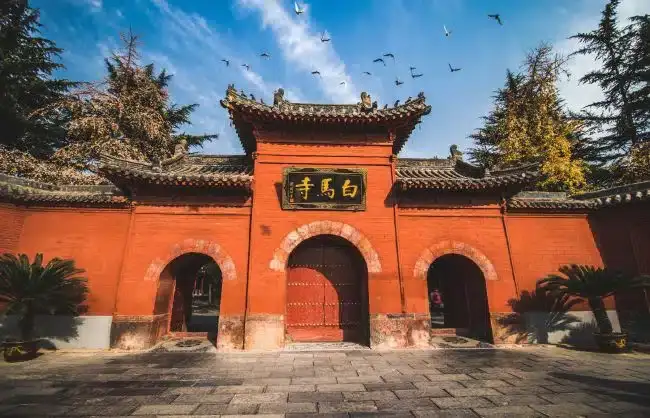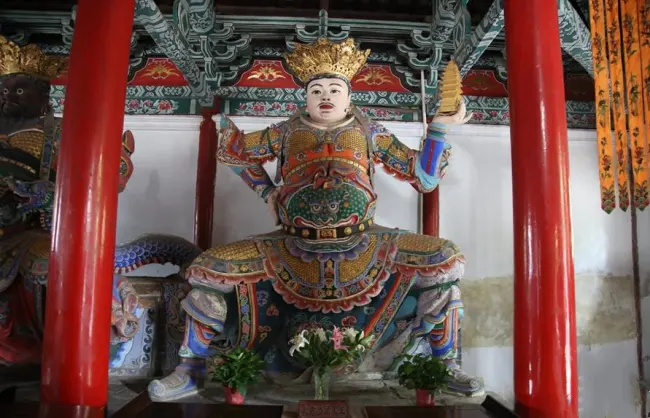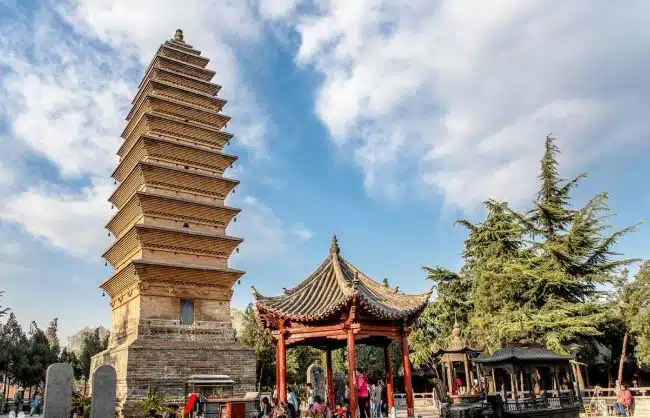White Horse Temple in Luoyang, the birthplace of Buddhism in China, was founded in the Eastern Han Dynasty (68 AD). It is the first Buddhist temple in China and a sacred place for Buddhist believers from all over the world.
The White Horse Temple is an important place for cultural exchange between Chinese and foreign Buddhists, influencing countries such as Vietnam, Korea and Japan. The temple has a profound influence on the development of Chinese Buddhism, which holds a large collection of Buddhist cultural relics and ancient books.
As a Buddhist landmark in China, it is an important attraction to explore the history of Buddhism during your travel to Luoyang.
Facts of White Horse Temple in China:
- In Chinese: Bái Mǎ Sì
- Location: Baima Temple Town, Luolong District, Luoyang City, Henan Province, China(about 12 km from Luoyang city).
- Opening time:7:40-18:40 (April 1st to October 7th); 8:00-17:30 (October 8th to March 31st)
- Ticket price: 35yuan (free for children under 1.4 meters)
- Time needed: 2 to 3 hours
- Best seasonsto visit: Spring and autumn
- Suited to: History lovers, culture lovers, Buddhists

The History of White Horse Temple
In 64 AD, Emperor Ming of the Han Dynasty sent envoys to the western regions to seek Buddhist teachings. Three years later, the envoys and two Indian monks returned to Luoyang on a white horse carrying Buddhist scriptures and statues. In 68 AD, the emperor ordered to build a Buddhist temple. The temple was named White Horse Temple in honor of the white horse carrying the scriptures.
During the Sui and Tang dynasties, due to the prosperity of Buddhism, White Horse Temple became a holy place for monks from all over the world to worship. During the Ming Dynasty, the White Horse Temple was renovated to its present size and layout.
Layout of White Horse Temple
The Luoyang White Horse Temple has a symmetrical pattern, with the main buildings distributed on the central axis. From south to north, there are Buddhist buildings such as Hall of the Heavenly King, and ancillary buildings on both sides such as the Bell and Drum Towers.
The layout of White Horse Temple reflects the features of traditional Chinese architecture and demonstrates the solemnity of the Buddhist temple.
What to See in White Horse Temple
There are many majestic Buddhist temples in White Horse Temple, including some masterpieces of Chinese Buddhist architecture, as well as temples from Thailand, India and Myanmar.
The Hall of the Heavenly Kings
The Hall of Heavenly Kings is the first major hall in Luoyang White Horse Temple, a traditional Chinese Buddhist building. The statue of Maitreya Buddha is enshrined in the center of the hall. The statues of Four Heavenly Kings are enshrined on both sides of the hall. And the statue of Heavenly General Wei Tuo is enshrined at the back of the hall.

The Hall of the Great Buddha
This hall is the main place for Buddhist activities in White Horse Temple. The statue of Sakyamuni Buddha is situated in the center of the hall. The statue of Manjusri Bodhisattva is situated on the left side. And the statue of Samantabhadra Bodhisattva is situated on the right side of the hall. These statues are all clay statues of the Ming Dynasty.
The Hall of Mahavira
As the largest hall in White Horse Temple, the Hall of Mahavira is built in the style of overhanging gable roof. The hall enshrines the statues of Shakyamuni, Amitabha, and Medicine Buddha, which are important Buddhist statues for Buddhists to worship.
The Hall of Guidance
This is the smallest hall in the main building of White Horse Temple. The main Buddha statues enshrined in the hall include Amitabha Buddha, Guanyin Bodhisattva, and Daisetsu Bodhisattva.
The Clear Cool Terrace
The Clear Cool Terrace is located at the highest point of Luoyang White Horse Temple. It is the first place to translate scriptures in China. After the Eastern Han Dynasty, the Clear Cool Terrace became a place to collect Buddhist scriptures at the White Horse Temple.
Pilu Pavilion
Pilu Pavilion is the last major hall built in the White Horse Temple. There are three clay statues from the Qing Dynasty, including Vairocana Buddha, Manjushri and Samandhabatra Bodhisattva. Behind the pavilion is a stone tablet inscribed with Sutra in Forty-two Sections, one of the earliest Chinese translations of Buddhist scriptures.
Qiyun Pagoda
The most important pagoda in Luoyang White Horse Temple is Qiyun Pagoda, which is located about 200 meters southeast of the gate. The pagoda is one of the few architectural relics of the Jin Dynasty, with a history of nearly 2,000 years.
Foreign Temples
There are several foreign temples in White Horse Temple, which were built by Thailand, Myanmar and India, reflecting the exchange of Chinese and foreign Buddhist culture.
These international Buddhist halls are all located on the west side of the White Horse Temple, of which the Thailand Buddhist temple is the largest one. These Buddhist buildings are well designed and magnificent, reflecting the Buddhist architectural features of various countries.
Best Time to Visit White Horse Temple
You can plan your Luoyang tours to White Horse Temple in spring (April to May) and autumn (September to November), which are the best time to visit White Horse Temple.
In spring, the weather of Luoyang is mild and with mostly sunny days. Trees are lush and flowers are blooming in White Horse Temple, especially cherry blossoms and peonies. You can take a lot of wonderful photos of White Horse Temple during this season.
In fall, the weather of Luoyang is cool and pleasant. The leaves of the ancient trees in the White Horse Temple turn golden, forming a beautiful picture with the red walls. You can capture the beautiful scenery and spectacular Buddhist buildings of the White Horse Temple and immerse in the serene atmosphere.

How to Get to White Horse Temple
By Bus
If you travel to White Horse Temple from Luoyangdong Railway Station, you can take bus 56 and 58 for about 1 hour and 20 min.
If you’re traveling from Luoyang downtown, you can take the bus 59/34 and then transfer to the bus 56 for about 1 hour and 40 min.
By Taxi
Take a taxi from Luoyangdong Railway Station to White Horse Temple, which takes about 24 minutes and costs 19-30 RMB.
Take a taxi from Luoyang downtown to White Horse Temple, which takes about 35 minutes and costs 29-44 RMB.
By Walk
There are many hotels around White Horse Temple, including starred hotel and quick hotel. You can choose to stay at these hotels and walk to the temple.
Attractions nearby Luoyang White Horse Temple
- Longmen Grottoes: As a World Heritage-listed site, it is one of the world’s largest treasures of stone carving art. The statues record the lives of ancient people, with great historical and cultural value.
- Luoyang Museum: There are six thematic exhibitions in this museum, which show the development of Luoyang civilization and reflect the outstanding skills of ancient craftsmen.
- Luoyang Ruins of Sui and Tang Dynasty:This is the site of the capital city in the Sui and Tang Dynasties, which has a history of over 1,400 years. It consists of the palace city, the imperial city and residential area.
- Luoyi Ancient City: Located in the old town of Luoyang, Luoyi Ancient City boasts many historical sites. Stroll around the ancient city, observe the city walls, ancient courtyards and old trees to feel the historical and cultural heritage of Luoyang.









